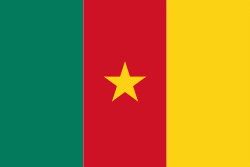Abong-Mbang (Abong Mbang)
Abong-Mbang is a town and commune in the East Region of Cameroon. Abong-Mbang is located at a crossroads of National Route 10 and the road that leads south to Lomié. Yaoundé, the capital of Cameroon, is 178 km to the west, and Bertoua, the capital of the East Province, lies 108 km to the east. From Ayos, at the border in the Centre Province 145 km (90 mi) from Abong-Mbang, the tar on National Route 10 ends and a dirt road begins. Abong-Mbang is the seat of the Abong-Mbang sub-division and the Haut-Nyong division. The town is headed by a mayor. Gustave Mouamossé has held the post since August 2002. Abong-Mbang is site of one of the East Province's four Courts of First Instance and a prefectural prison. The population was estimated at 18,700 in 2001.
According to oral traditions of the Kwassio and Bakola peoples, Abong-Mbang was settled when the Maka-Njem peoples moved northwest from the Great Lakes region of the Congo River. They encountered Pygmy hunter-gatherers and requested their aid as guides through the region. Some of the migrants settled in the vicinity, which they called Bung-Ngwang ("bathing area in the Nyong River"). When Europeans arrived in the 19th century, this name was changed to Abong-Mbang. Some migrants continued westward in search of salt; they became the Kwassio and Bakola of Cameroon's coast. German colonisers moved into the area in the late 19th century. They used the Nyong River as a means to reach the wild rubber growing farther inland. The Germans built a fort and other military and administrative buildings in the town. The fort is today a prefectural prison, and the other buildings serve similar administrative functions. The French took over in 1919 following Germany's defeat in World War I.
According to oral traditions of the Kwassio and Bakola peoples, Abong-Mbang was settled when the Maka-Njem peoples moved northwest from the Great Lakes region of the Congo River. They encountered Pygmy hunter-gatherers and requested their aid as guides through the region. Some of the migrants settled in the vicinity, which they called Bung-Ngwang ("bathing area in the Nyong River"). When Europeans arrived in the 19th century, this name was changed to Abong-Mbang. Some migrants continued westward in search of salt; they became the Kwassio and Bakola of Cameroon's coast. German colonisers moved into the area in the late 19th century. They used the Nyong River as a means to reach the wild rubber growing farther inland. The Germans built a fort and other military and administrative buildings in the town. The fort is today a prefectural prison, and the other buildings serve similar administrative functions. The French took over in 1919 following Germany's defeat in World War I.
Map - Abong-Mbang (Abong Mbang)
Map
Country - Cameroon
 |
 |
| Flag of Cameroon | |
Early inhabitants of the territory included the Sao civilisation around Lake Chad, and the Baka hunter-gatherers in the southeastern rainforest. Portuguese explorers reached the coast in the 15th century and named the area Rio dos Camarões (Shrimp River), which became Cameroon in English. Fulani soldiers founded the Adamawa Emirate in the north in the 19th century, and various ethnic groups of the west and northwest established powerful chiefdoms and fondoms. Cameroon became a German colony in 1884 known as Kamerun. After World War I, it was divided between France and the United Kingdom as League of Nations mandates. The Union des Populations du Cameroun (UPC) political party advocated independence, but was outlawed by France in the 1950s, leading to the national liberation insurgency fought between French and UPC militant forces until early 1971. In 1960, the French-administered part of Cameroon became independent, as the Republic of Cameroun, under President Ahmadou Ahidjo. The southern part of British Cameroons federated with it in 1961 to form the Federal Republic of Cameroon. The federation was abandoned in 1972. The country was renamed the United Republic of Cameroon in 1972 and back to the Republic of Cameroon in 1984 by a presidential decree by president Paul Biya. Paul Biya, the incumbent president, has led the country since 1982 following Ahidjo's resignation; he previously held office as prime minister from 1975 on. Cameroon is governed as a Unitary Presidential Republic.
Currency / Language
| ISO | Currency | Symbol | Significant figures |
|---|---|---|---|
| XAF | Central African CFA franc | Fr | 0 |
| ISO | Language |
|---|---|
| EN | English language |
| FR | French language |















